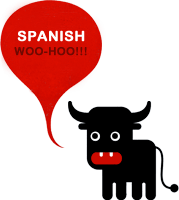Daily Life in Spain
One of the first things that people seem to notice on arrival in Spain is how late everything seems to be; the post being delivered, the bins being collected, the friend turning up over half an hour late for drinks. Not only can this be aggravating to start off with, as you feel as though you are constantly waiting around, but it can also throw visitors off completely. In terms of eating times and the general layout of the day, Spaniards are no exception to this general consensus.
Work

To many of us, starting the working day at 10am is late, in fact it sounds more like a weekend, yet the majority of employees in Spain won’t being their working day until after 9.30am and you’ll find that the hour between 9 and 10am is peak morning rush hour. In the UK this is generally assumed to be an hour, if not two, earlier, with most companies expecting employees to be at their desks by 8.30 at the latest. However, this doesn’t generally mean that Spaniards have an easier time than we do, because despite a late start they do still tend to work the same hours as us, if not more. Thanks to a leisurely hour or two lunch break and a climate that preserves daylight until up to 10pm at night, business continues as usual until the sun goes down and the midday heat has well and truly faded.
Eating
One of the most important parts of the Spanish culture is eating and enjoying a cold, refreshing copa de vino (glass of wine) or una caña (small glass of beer) and, seeing as it’s the main meal of the day here, lunch is no exception. Whether you work full-time or not, lunch is the most important time of the day with most companies allowing an hour or two for staff to really make the most of the midday sun. Most cafés tend to promote lunch menus at really decent prices and these are usually 3 or 4 courses including wine. A typical menu would include gazpacho or perhaps a small salad to begin with followed by a decent portion of pasta, steak, seafood or other meat as a main course and then a dessert and possibly coffee. Definitely a far cry from the typical sandwich and bag of crisps that we’re used to in England!

Tapas is also a very popular cuisine all over Spain and there is no shortage of bars and cafés offering small plates of olives, tortilla, calamari, potato, bread and various meats; there is always something likely to take your fancy and you’ll find that the best tapas places are usually busy all day long (which is the best way to pick out the better restaurants).
The fact that lunch is the most important meal of the day doesn’t necessarily mean that dinner is a quiet affair; in fact it is quite the opposite! The main difference between the evening meal in Spain and in the UK is the time at which families sit down to enjoy it. Whereas in England dinner is usually on the table by around 6pm, in Spain this tends to take place considerably later, usually when it goes dark after 9pm. Due to having a long lunch, eating so much later on isn’t a problem and restaurants are open until much later. I noticed that, in the city, queues for seating didn’t begin until after 9pm in the evening and then continued to build up until around 11pm, which is completely normal in Spain.
Weekends
Like most places, Saturday is the busiest day of the week in city centres and towns with most families heading out to buy fresh bread and fruit for the family, visit friends or just wander through parks enjoying the sunshine. Most bars and outdoor restaurants are full by the time the sun goes down on Saturday evening while locals enjoy a relaxing drink and bite to eat.
 Sundays can vary depending on the size of the city with most shops and supermarkets remaining open all day in the larger cities such as Madrid and Barcelona to a complete shut down of all businesses in the smaller pueblos and villages. Quite a lot of Spanish local people will rise early on Sunday to attend church service, principally the older generations as well as families with children, who then lunch together dressed in their Sunday best. It’s not uncommon to see older couples dressed pristinely meandering through the streets but usually in smaller villages it’s highly unlikely that many people will go out at all; Sunday is a day of rest.
Sundays can vary depending on the size of the city with most shops and supermarkets remaining open all day in the larger cities such as Madrid and Barcelona to a complete shut down of all businesses in the smaller pueblos and villages. Quite a lot of Spanish local people will rise early on Sunday to attend church service, principally the older generations as well as families with children, who then lunch together dressed in their Sunday best. It’s not uncommon to see older couples dressed pristinely meandering through the streets but usually in smaller villages it’s highly unlikely that many people will go out at all; Sunday is a day of rest.
Nightlife
The nightlife in Spain varies according the location, and larger clubs tend to be found in cities and towns with a large population of students. Clubs usually stay open till around 6am and they tend to stay busy until closing, especially when most students don’t even arrive there until 2am.
One of the most popular things to do at night among the younger generation is botellón, basically a massive outdoor gathering in a public place where youths go to drink, chat and meet up. Although it is illegal to drink in public in Spain, this youth culture has endured and botellón takes place in most towns and cities no matter what size with most young people from the area turning up to meet and drink together.
Siesta
Despite rumours that the whole siesta culture is a complete myth, it’s not uncommon for local businesses to completely shut down for a few hours in the afternoon (usually between 2pm and 5pm). For many, this also constitutes as a lunch hour and allows most working Spaniards to escape the midday heat, eat and possibly take a short nap. In larger cities it’s almost impossible to tell when a siesta is taking place due to the fact that most high street shops and souvenir stalls remain open so as not to lose business and most of the biggest supermarkets and stores will remain open throughout the day. In towns and villages however it is completely normal for a whole high street to close down for a few hours and then return to business fresh and full for a busy afternoon, even on a Saturday! It’s surprising how little ground you have to cover after leaving the centre of a city to find yourself in a ghost town just half an hour away.









